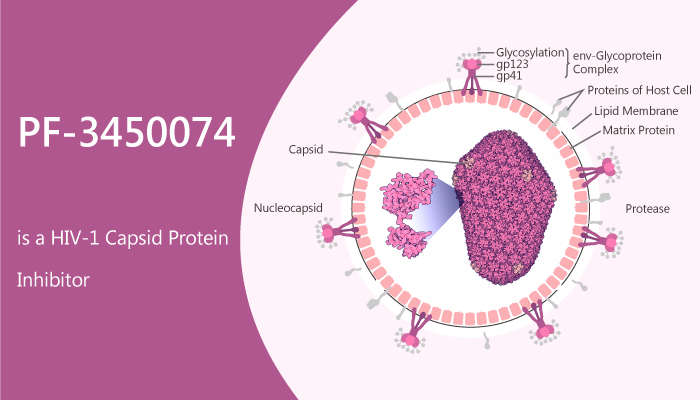Human immunodeficiency virus type 1 (HIV-1) infection leads to depletion of the immune dysfunction. Thereby results in immunodeficiency and vulnerability to opportunistic infections.
As we all know, in the past decades, there exist multiple drugs targeting viral enzymes, reverse transcriptase and protease. Such therapies achieve success in reducing the level of circulating virus and the emergence of drug-resistant viral mutants. However, even the most effective current therapy can not eliminate the virus, and incomplete patient adherence to therapy promotes the emergence of drug-resistant mutants.
HIV-1 infection depends on the proper disassembly of the viral capsid, or “uncoating,” in target cells.
The HIV-1 capsid contains a conical multimeric complex of the viral capsid protein (CA). Destabilize the arrangement of CA would lead to an impaired infection.
In this article, we will introduce a specifical inhibitor of HIV-1 CA, PF-3450074.

PF-3450074 destabilizes the viral capsid. Furthermore, it binds to HIV-1 particles and acts at an early stage of HIV-1 infection by inhibiting virus reverse transcription in target cells. PF-3450074 also inhibits HIV isolates with submicromolar potency (EC50=8-640 nM).
Firstly, PF-3450074 exhibits anti-viral activities against HIV wild type NL4-3 and HIV T107N mutant with EC50 values of 0.72 μM and 4.5 μM, respectively.
Nextly, PF-3450074 displays a good potency in primary human peripheral blood mononuclear cells (PBMCs). It inhibits HIV-193RW025, HIV-1JR-CSF and HIV-193MW965 with IC50 values of 1.5 μM; 0.6 μM; and 0.6 μM, respectively. This compound shows Median IC50 and CC50 values of 0.9 μM and 90.5 μM, respectively. The Kd for the interaction between PF-74 and the CA hexamer derived in the same manner as for NUP153, the value is determined to be 176 nM.
Lastly, in HeLa-P4 cells, PF-3450074(10 μM; 8 hours) results in a marked reduction in late products of reverse transcription with DNase I-treated stocks of Env-defective HIV-1.
In conclusion, PF-3450074 is a viable candidate compound that targets this inter-protomer pocket on HIV-1 CA and inhibits viral replication. Moreover, It has high biological activity with median IC50 values ≤ 10 nM against HIV-1 subtypes A/B/C. Besides, PF-3450074 has improved solubility, and exhibits in vitro half-life (T½) in human liver microsomes of greater than 90 minutes.
Reference:
[1]. Xu JP, et al. J Drug Des Res. 2018;5(2). pii: 1070. Epub 2018 Aug 13.
[2]. Shi J, et al. J Virol. 2011 Jan;85(1):542-9.